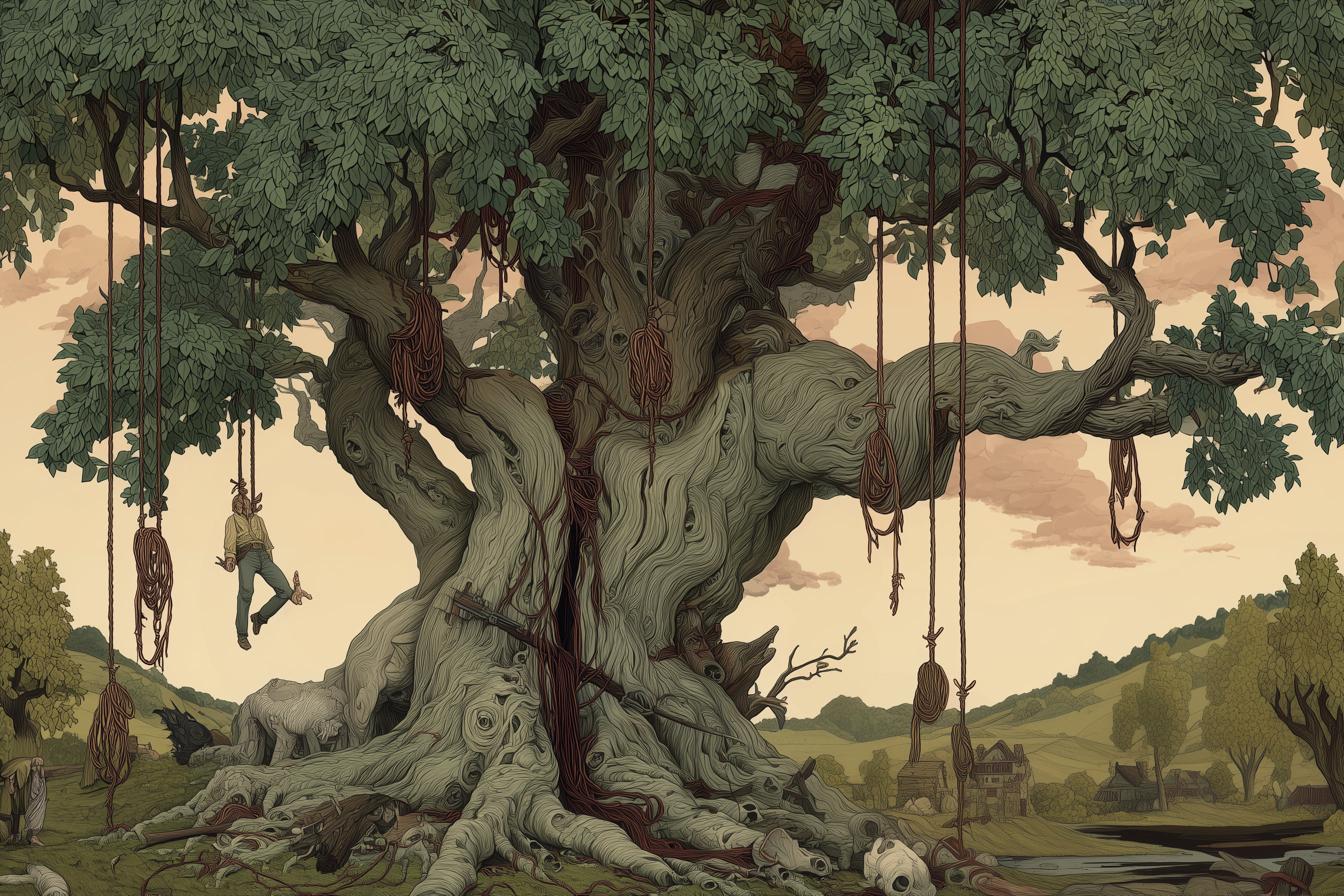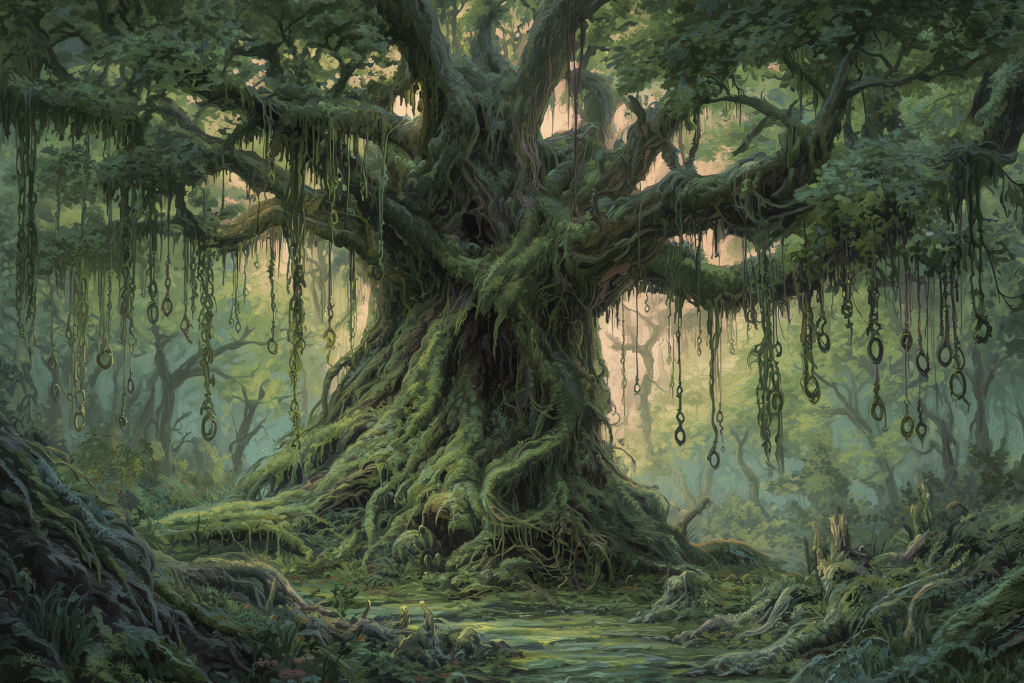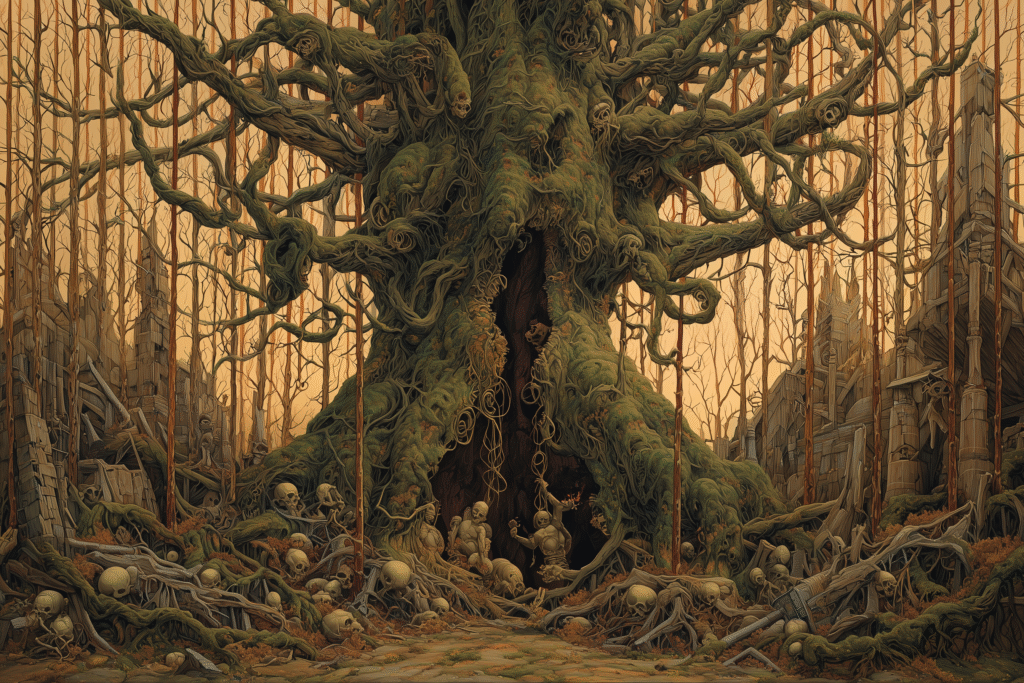Hangman Tree, Executioner of the Wildwood
“The Hangman Tree waits in silence—its noose-like vines ready to strangle the unwary and swallow them whole.”

The Hangman Tree is a towering monstrosity reaching up to 30 feet in height, with a massive, gnarled trunk and bark like weathered flesh. From its sprawling canopy hang dozens of thick, greenish vines resembling ropes, each ending in a looped noose that sways unnaturally, even when there is no wind. Its broad leaves exude a faint phosphorescent sheen at night, and knotholes along its trunk form unsettling, almost face-like patterns. The base of the tree is often surrounded by bleached bones, scraps of armor, and the detritus of past victims.
Behavior
Despite its size, the Hangman Tree is unnervingly still, capable of remaining motionless for months while waiting for prey. It is not mindless—it possesses a cunning, predatory instinct, and can distinguish between armed threats and easier targets. When potential prey draws near, the tree lashes out with blinding speed, snaring victims with its vines and hoisting them aloft to strangle them slowly. It prefers to keep multiple victims dangling, letting them weaken and ripen over time, feeding slowly and savoring each kill.
The Hangman Tree is territorial and solitary, communicating in a limited fashion with others of its kind through deep-rooted pheromonal signals or by exhaling bursts of hallucinogenic spores that muddle the senses of intruders. It can mimic the harmless posture of an ordinary tree using its hallucinatory spores, allowing it to mislead entire groups before striking.
Habitat
Hangman Trees are most often found in remote, temperate forests, especially along disused game trails or long-forgotten roads. They prefer quiet, undisturbed groves, where the cover of dense foliage and the isolation of the wilderness make it easy to ambush prey. Some are known to take root near ancient ruins, battlefields, or gallows, feeding off the lingering essence of death.
Modus Operandi
The Hangman Tree does not chase—it waits. When a creature comes within range, the tree lashes out with multiple vine-like tendrils, attempting to grapple and constrict. Once restrained, the victim is lifted high into the canopy, strangled over several agonizing minutes, and eventually swallowed whole through a gaping maw that opens in the tree’s trunk. It never feeds on more than one victim at a time, preferring to let others hang as deterrents or future meals.
Its hallucinatory spores further complicate its ambushes, making it appear as a harmless or even friendly tree. This illusion can turn experienced adventurers into passive bystanders while their allies are strangled before their eyes.
Motivation
While not driven by malice in the mortal sense, the Hangman Tree exhibits a malignant cunning and sadistic patience. It kills to feed, but also appears to enjoy the ritual of the kill—the slow strangulation, the isolation of victims, the illusion of safety before the strike. Some sages speculate these trees were born of dark druidic experiments or cursed groves, infused with hatred for those who desecrate the forest.
It is motivated by hunger, territorial instinct, and a cruel, alien intelligence that delights in the suffering of the living.
Hangman Tree 5e
Hangman Tree, Pathfinder
Hangman Tree

Huge Plant, Neutral Evil
Challenge: 9 (5,000 XP) | Proficiency Bonus: +4
Armor Class 17 (natural armor)
Hit Points 142 (15d12 + 45)
Speed 10 ft.
| STR | DEX | CON | INT | WIS | CHA |
|---|---|---|---|---|---|
| 24 (+7) | 6 (−2) | 17 (+3) | 6 (−2) | 14 (+2) | 10 (+0) |
Saving Throws
Con +7, Wis +6
Skills
Perception +10
Damage Vulnerabilities
Lightning
Damage Resistances
Bludgeoning, piercing (nonmagical)
Damage Immunities
Poison
Condition Immunities
Blinded, deafened, exhaustion, prone
Senses
Blindsight 60 ft. (blind beyond this radius), passive Perception 20
Languages
Understands Sylvan but cannot speak
Traits
False Appearance. While motionless, the Hangman Tree is indistinguishable from an ordinary tree. A creature can discern its true nature with a successful DC 18 Intelligence (Nature) or Wisdom (Survival) check made as an action.
Multiple Vines. The Hangman Tree can extend up to three vines at once. Each vine can grapple one creature independently. The tree is not considered grappled when it grapples other creatures.
Grasping Nooses. When the tree hits a Medium or smaller creature with a vine, it can attempt to grapple the target (escape DC 17). A grappled target is restrained and lifted 15 feet into the air, becoming suspended unless immune to forced movement.
Plant Traits. The Hangman Tree does not require air, food, or sleep.
Actions
Multiattack. The Hangman Tree makes up to three Vine Lash attacks, each targeting a different creature. If two or more attacks hit the same creature, the second may initiate a strangulation effect.
Vine Lash. Melee Weapon Attack: +11 to hit, reach 20 ft., one target.
Hit: 13 (2d6 + 7) bludgeoning damage. Medium or smaller targets must succeed on a DC 17 Strength saving throw or become grappled and restrained.
Constrict. Grappled targets take 13 (2d6 + 7) bludgeoning damage at the start of their turns. If restrained for two consecutive turns, they begin suffocating unless they can breathe without air.
Swallow Whole. The Hangman Tree may swallow one Medium or smaller creature it has grappled and lifted. The target must succeed on a DC 17 Dexterity saving throw or be swallowed.
While swallowed, the creature is blinded and restrained, has total cover, and takes 17 (5d6) acid damage at the start of each of the tree’s turns. A swallowed creature may attempt to cut its way out by dealing 30 slashing damage (AC 15) in a single turn. Once the creature exits, the opening closes at the end of that turn.
Hallucinatory Spores (Recharge 5–6). The tree releases a 30-foot-radius cloud of hallucinogenic spores. Each creature in the area must make a DC 16 Wisdom saving throw or be charmed for 1 minute, perceiving the tree as harmless or even friendly.
While charmed in this way, a creature cannot target the tree with attacks or harmful abilities. The creature may repeat the saving throw at the end of each of its turns, with advantage if it or an ally is harmed.
Reactions
Thrashing Tangle (1/Turn). When a creature within 20 feet hits the tree with a melee attack, the Hangman Tree may make one Vine Lash attack against the attacker.
Tactics and Behavior
The Hangman Tree prefers ambushes, remaining motionless to take advantage of its False Appearance and Hallucinatory Spores. It focuses on isolated or vulnerable targets, lifting them into the air and strangling or swallowing them while threatening others with multiple vines. It ignores creatures it cannot digest, such as undead or constructs, and retreats only when significantly damaged.
Environment
Temperate forests, cursed groves, or abandoned roads. Often found near ruins or ancient execution sites. Signs of its presence include scattered bones, shredded equipment, or the remains of victims still hanging from its vines.
Treasure
The Hangman Tree collects no treasure intentionally, but remnants of victims may yield standard loot for a CR 9 creature, including weapons, valuables, or botanical magic items (e.g., staff of the woodlands, entwining whip, seed of rebirth).
Hangman Tree

This sinister tree looms above a field strewn with bones. numerous leafy vines, their tips looped into nooses, hang from its branches.
The hangman tree prefers to lie in wait near remote forest tracks and game trails, waiting for victims to wander by. These carnivorous plants are incredibly patient, and can wait for months in a single location for food to approach. When prey does draw near, the tree’s vines lash like striking snakes. The tree often uses its pull ability to hoist grappled foes 10 to 15 feet in the air so that they are out of reach of allies while they slowly strangle. The tree generally only swallows one foe whole at a time, letting its other captured victims dangle and ripen until it is ready to feed on them.
A hangman tree is 30 feet tall and weighs 12,000 pounds
| Hangman Tree CR 7 |
| XP 3,200 NE Huge plant Init +3; Senses Blindsight 60 ft.; Perception +11 |
| DEFENSE |
| AC 20, touch 7, flat-footed 20 (-1 Dexterity, +13 natural, -2 size) hp 84 (8d8+48) Fort +12, Ref +3, Will +5 Immune plant traits; SR 18 Weaknesses vulnerable to electricity |
| OFFENSE |
| Speed 10 ft. Melee 3 vines +11 (1d6+7 plus grab and pull) Space 15 ft.; Reach 15 ft. Special Attacks constrict (1d6+7), hallucinatory spores, pull (vine, 5 feet), strangle, swallow whole (2d6+7 acid damage, AC 16, 7 hp), vines |
| STATISTICS |
| Strength 25, Dexterity 8, Constitution 23, Intelligence 7, Wisdom 12, Charisma 10 Base Atk +6; CMB +15 (+19 grapple); CMD 24 Feats Improved Initiative, Iron Will, lightning reflexes, skill focus (Perception) Skills Perception +11, Stealth -2 Languages Sylvan |
| SPECIAL ABILITIES |
| Hallucinatory Spores (Ex) Once per day as a standard action, a hangman tree can release a cloud of spores in a 50-foot-radius spread. Creatures in the area must make a DC 20 Will save or believe the hangman tree to be a perfectly ordinary tree or at worst, a treant or some other friendly tree-like creature. An affected creature becomes passive for 2d6 minutes and refuses to attack the hangman tree during this time. An affected creature can attempt a new Will save each round that the tree attacks an ally if a hallucinating creature is attacked by the tree, it gains a +4 bonus on its Will save to see through the hallucination. This is a mind-affecting compulsion effect. The save DC is Constitution-based. Vines (Ex) A hangman tree’s vines are primary attacks that deal bludgeoning damage. When a hangman tree grapples a foe with its vines, the tree does not gain the grappled condition. A hangman tree that uses swallow whole transfers a pinned creature from a vine to inside its trunk. |
| ECOLOGY |
| Environment temperate forests Organization solitary or pair Treasure standard |
__________________________________________
Section 15: Copyright Notice – Bestiary 2
Pathfinder Roleplaying Game Bestiary 2, © 2010, Paizo Publishing, LLC; Authors Wolfgang Baur, Jason Bulmahn, Adam Daigle, Graeme Davis, Crystal Frasier, Joshua J. Frost, Tim Hitchcock, Brandon Hodge, James Jacobs, Steve Kenson, Hal MacLean, Martin Mason, Rob McCreary, Erik Mona, Jason Nelson, Patrick Renie, Sean K Reynolds, F. Wesley Schneider, Owen K.C. Stephens, James L. Sutter, Russ Taylor, and Greg A. Vaughan, based on material by Jonathan Tweet, Monte Cook, and Skip Williams.

 Buy me a coffee
Buy me a coffee